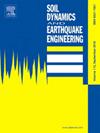Dynamic response analysis of vehicle-track coupled system at subgrade-bridge transition zone in seasonal frozen region under multi-source excitation
IF 4.2
2区 工程技术
Q1 ENGINEERING, GEOLOGICAL
引用次数: 0
Abstract
It is the key to ensure the safe operation of high-speed railway to explore the dynamic performance evolution of the vehicle-track coupled system under the conditions of multi-source excitation, such as environment and wheel-rail diseases. Based on the vehicle-track coupled dynamics and thermodynamic theory, a model under the interaction of an environment-vehicle-track-foundation structure at the subgrade-bridge transition zone in seasonal frozen region is established, in which the environment is typically represented by temperature. Besides, combined with a large number of monitoring data, the deformation of the foundation structure at the subgrade-bridge transition zone of high-speed railway in the seasonal frozen region and the evolution law of the vehicle-track dynamic response caused by the deformation are analyzed, as well as the causes of the lateral acceleration over-limit of the frame at the subgrade-bridge transition zone are particularly explored. The results indicate that significant follow-up deformation of frost heave and thaw settlement can occur in the rail-track-foundation structure. The influence of freeze-thaw and differential settlement on wheel-rail vertical force is much larger than that of frost heave in the mid-temperature seasonal frozen region with annual temperature of −20 °C–40 °C. In addition, the depression on both sides of the rail surface caused by the distortion of the rail at the abutment and bridge end is the main reason for the increase of the lateral vibration of the frame at the transition zone.
求助全文
约1分钟内获得全文
求助全文
来源期刊

Soil Dynamics and Earthquake Engineering
工程技术-地球科学综合
CiteScore
7.50
自引率
15.00%
发文量
446
审稿时长
8 months
期刊介绍:
The journal aims to encourage and enhance the role of mechanics and other disciplines as they relate to earthquake engineering by providing opportunities for the publication of the work of applied mathematicians, engineers and other applied scientists involved in solving problems closely related to the field of earthquake engineering and geotechnical earthquake engineering.
Emphasis is placed on new concepts and techniques, but case histories will also be published if they enhance the presentation and understanding of new technical concepts.
 求助内容:
求助内容: 应助结果提醒方式:
应助结果提醒方式:


